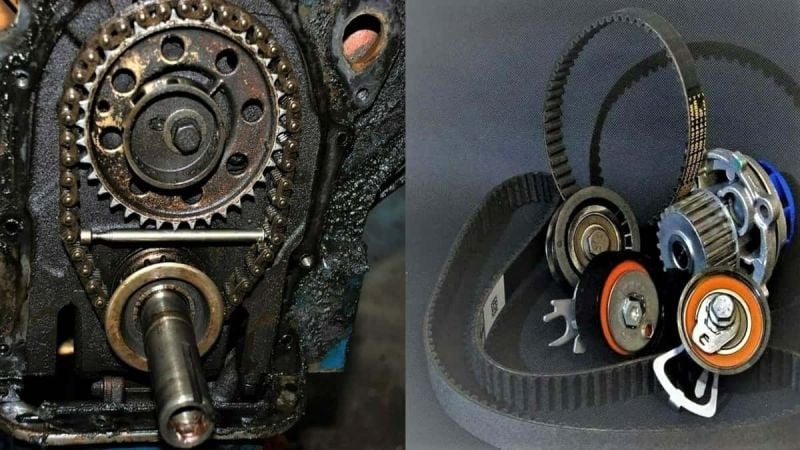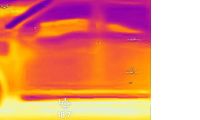Controlling an Engines’ Timing
Today’s topic is filled with a lot of useful information for car owners who have heard about the high costs of when an engine fails because a timing chain or belt has broken and/or the high cost of a service and repair when a mechanic or service technician comes to you and recommends replacing a timing chain/belt to prevent future and more expensive engine problems down the road.
Basically whether it is a timing chain or a timing belt your car uses, its job is to ensure that the fuel intake and exhaust valves are in sync with the correct pistons at the correct moments during the four strokes of engine piston operation: (1) taking fuel in downstroke with intake valves open and exhaust valve closed; (2) compressing the fuel for spark igniting of the fuel, upstroke with both intake and exhaust valves closed; (3) power downstroke of the fired piston to deliver power to the crankshaft with intake and exhaust valves still closed; and (4) exhaust upstroke to open the exhaust valves to exhaust out the burnt gases while the intake valves are closed.
Whether you have a 4, 6, or 8-cyclinder engine in your car this is the fundamental process each cylinder goes through as the crankshaft spins and positions your pistons in a particular order in the block. The camshaft’s job is to operate the engine’s valves, while the crankshaft sends the up-and-down movement of the rods and pistons to the transmission and forward to the wheels.
For another explanation of this process and addressing the similarities and differences of a timing belt and a timing chain, here is a short video by one of today’s featured mechanics that offers a fair amount of useful information car owners should be aware of whether they DIY their repairs or take it to a mechanic in a garage.
Timing Belt vs Timing Chain, Which is Better?
Interference Engines
Along with the timing belt and timing chain, what can happen to an engine should either fail also plays into whether or not you have an interference type engine or a non-interference type engine.
Basically, the difference between the two is that in a non-interference type engine the valve placement and pistons have a clearance that prevents them from whacking against each other should the timing become seriously out of sync when a timing belt or chain breaks and the crankshaft and camshaft---and thus the valves and pistons---are no longer communicating properly with each other.
However, if it is an interference type of engine, the valve placement and its clearance between it and the piston is such that when the crankshaft and camshaft are not in sync, the clearance between the valves and the piston head is significantly narrower resulting in pistons and valves smashing against each other and causing serious engine damage. Interference engines are designed this way to create a smaller engine with higher performance using larger valves and higher compression ratios.
For a visual of how the valves and pistons can hit each other when a timing chain is not on a block when the crankshaft spins, here is a very short video showing that the two can impact each other in an interference engine enough to raise the cylinder head off of the block.
Demonstration of Interference Engine
Will an Interference Engine Timing Belt/Chain Failure ALWAYS Result in Catastrophic Engine Damage?
The genesis of today's article is due to a recent video from the ETCG1 YouTube channel video where its host “Eric” reveals that with an interference engine, not always will severe engine damage result when a timing chain or belt fails.
According to the host, when his 2008 Acura TL died on the road recently due to the timing belt breaking on his J-32 series interference-type engine, he discovered that his repairs were limited to just replacing the water pump and installing a new timing belt. In other words---his engine escaped expected internal damage.
Here’s the video and his message of why this discovery is important to car owners with vehicles that have an interference-type engine.
What Is an Interference Engine?
The Point to All of This
The point to all of this is that not just car owners but reputable mechanics as well will argue over whether or not you should buy a car with a timing belt or timing chain and whether you should avoid any make and model that comes with an interference versus a non-interference type engine.
With engines like everything else in life, there are almost no absolutes and there are usually always exceptions. However, with the above demonstrations and explanations, the point of this article is to add to your knowledge when it comes to understanding new and used cars and your buying decisions.
Related article: The Best Used Car Deals Mechanics Recommend Against Buying
Related article: Engine Swapping Expert Reveals the Realities About Engine Replacement
That said, here are some related bonus videos that show an actual timing chain replacement and some added reality of what happens during actual timing chain related repairs.
Related article: Ford Mechanic Catches Engine Rebuild Scam
Timing Chain Replacement Demo
For those of you would like to see what is involved in a timing chain replacement (not involving a timing chain failure), here is an excellent example from Rainman Ray’s Repairs YouTube channel where Ray takes viewers along as he replaces the timing chain on a 2004 Ford Mustang.
The value of this two-part video is that it will show you:
• What it takes to access the timing chain
• Timing chain alignment marks important for reinstalling a new chain
• An example of what mechanics have to go through with a jerry-rigged repair someone did to hide/fix a broken timing cover
• An example of where sometimes the wrong part gets delivered after ordering
• What it takes to put it all back together
This is a 2-part video that is time well-spent for anyone interested in a DIY repair and/or just wants to know what a timing chain replacement can entail. Please note that this is with a 2004 Ford Mustang and that although similar, other car makes and models will differ somewhat.
Part 1: Silicone EVERYWHERE! Botched Timing Cover Reseal! I broke it more! Ford Mustang 2004 3.9
Part 2: Wrong Timing Chain Installed! 2004 Ford Mustang!
And finally…
For additional articles about engine maintenance and engine problems, check out these two selected article about “Subaru Crosstrek Engine Oil Analysis After 3,000 Mile Test” and "Consumer Reports Analysts Reveal the Used Cars Most Likely to Need an Engine Rebuild and What to Buy Instead.”
COMING UP NEXT: Just Rolled In Car Customer Fails
Timothy Boyer is a Torque News automotive reporter based in Cincinnati. Experienced with early car restorations, he regularly restores older vehicles with engine modifications for improved performance. Follow Tim on Twitter at @TimBoyerWrites for daily new and used vehicle news.
Image Courtesy of Pixabay and Writer












Comments
Thanks very much for the
Permalink
Thanks very much for the information.